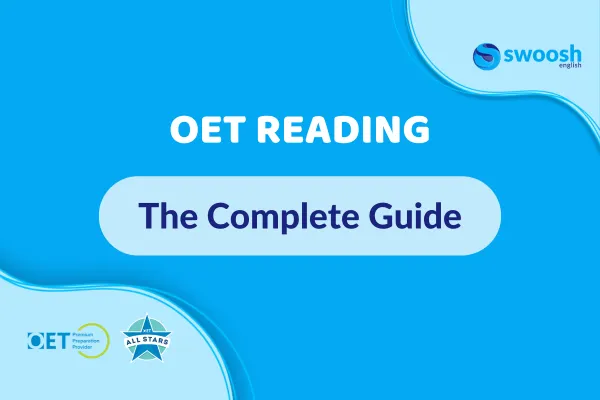Want to pass your OET exam faster?
Blog
Dive into our OET, IELTS or PTE blogs full of tips and strategies so you can achieve your goal of passing your exam with confidence.


The Complete Guide to OET Reading
Welcome to our OET Reading Guide! At Swoosh English, we prioritise your success and are dedicated to helping you achieve your goals. We understand that tackling various texts under exam conditions can be daunting. In the OET Reading exam, not only must you provide accurate answers, but you must also do so within strict time constraints.
Maintaining focus and avoiding panic might sound simple in theory, but executing them during the exam can be challenging. However, armed with the right approach and strategies, you can confidently stride into the OET reading exam knowing you can pass. This guide equips you with essential information to become a proficient OET reader and realise your career aspirations.
Understanding the OET Reading Test
The OET Reading test assesses the English proficiency of medical professionals. Unlike the OET Writing and Speaking tests, it doesn't cater to professionals from specific medical backgrounds. Instead, it mirrors the broader experiences of medical professionals both within and outside the workplace.
The exam spans 60 minutes and comprises three sections.
Section A is brief, lasting 15 minutes, featuring four short texts within a specific medical domain. You must answer 20 questions, each worth one mark, within this timeframe.
The questions are divided into three sets, each containing between six to seven items with varying question types.
First, you encounter matching questions, where you must pair each question with one of the four texts. Next, you tackle gap-fill and short answer questions, requiring responses ranging from one to three words.
It's crucial to complete Part A within 15 minutes, as the invigilator collects the section once the time elapses. Subsequently, you proceed to sections B and C, where you have 45 minutes to answer a total of 22 questions, each worth one mark.
Section B consists of six multiple-choice questions, each accompanied by a short text resembling workplace materials like notices, training manuals, or work emails.
Section C presents two longer texts and 16 multiple-choice questions, with eight questions corresponding to each text. These texts delve into recent medical research and possess a more academic tone.
Preparation Strategies for the OET Reading Test
Familiarise Yourself with the Exam
Begin by thoroughly understanding the exam format and procedures to avoid confusion or surprises during the test. Analyse sample tests repeatedly to ensure clarity.
Assess Your Level
Evaluate your current proficiency level to gauge your readiness for achieving a grade B or above in OET Reading. Take our OET Exam Readiness Test for personalised feedback on your skills.
Engage in Reading Practice
Based on your assessment, engage in plenty of reading practice to familiarise yourself with the exam format. Take OET mock reading tests to track your progress accurately. Additionally, diversify your reading materials to include medical journals, websites, and newspaper articles, particularly those related to medicine and health.
Seek Guidance from Qualified OET English Teachers
Develop specific reading strategies essential for excelling in the exam, such as reading for gist, specific information, detecting opinions, and recognising cohesion features. Benefit from personalised lessons with our qualified OET teachers, who provide targeted practice and guidance, ensuring you're fully prepared for the exam.
Preparing for Each Part of the OET Reading Test
Part A: Skimming
Upon entering the exam room, promptly employ key reading strategies, especially since you have limited time for Part A. Start by skimming through the four short texts to grasp their main content and purpose, and spend no more than five minutes in total on the initial matching questions.
Part A: Scanning
The subsequent question sets test your scanning abilities. Determine which text corresponds to each question based on your skimming and swiftly scan through the texts to locate specific information required for answering the questions.
Part A: Being Prepared to Skip a Question
If a particular question proves challenging during scanning, skip it and proceed to the next. With only 15 minutes for 20 questions, allocate approximately 45 seconds per question to ensure optimal time management. You can revisit skipped questions if time permits.
Part B: Making Use of Background Knowledge
Leverage your professional background knowledge to contextualise the information presented in Part B texts. These texts resemble workplace materials you're likely familiar with, allowing you to anticipate content and enhance comprehension.
Part B: Reading the Options Carefully
Carefully read all three answer options provided for each question in Part B. Unlike Part A, scanning alone may not suffice for accurate answers. Pay attention to details and ensure a comprehensive understanding of each option's overall meaning.
Part B: Recognising Paraphrasing and Avoiding Distractors
Upon reading the answer options, proceed to examine the texts with equal attention. Expect paraphrased answers in the text and prioritise understanding the underlying meaning rather than mere word matching. Avoid being misled by distractors and aim for precise selections.
Part C: Reading for Gist
In the final part of the exam, you can quickly skim through the longer texts to establish context for answering the questions in Part C. This preliminary overview facilitates comprehension and aids in navigating the questions effectively, but ensure you don’t waste too much time doing this, as you’ll need to slow down later for a more careful reading of the text.
Part C: Identifying Opinions
Questions in Part C often require identifying opinions expressed by writers or individuals mentioned in the texts. Pay close attention to evaluative language, such as adjectives and modal verbs, to discern and accurately interpret opinions. Thoroughly analyse questions and text details to ensure precise responses.
Part C: Recognising Referencing and Detecting Meaning from Context
Part C includes questions on recognising references and detecting meaning from context. Utilise surrounding contextual clues to decipher the meaning or reference of specific words or phrases. Note details such as part of speech and connotations to facilitate accurate interpretation.
The OET Reading Checklist
In summary, follow these steps for OET Reading success:
Familiarise yourself with the exam format and procedures.
Assess your current proficiency level by taking an exam readiness test.
Engage in extensive reading practice, including mock tests and diverse reading materials.
Seek guidance from qualified OET English teachers to develop essential reading strategies.
Employ skimming and scanning techniques for efficient completion of Part A.
Leverage your professional background knowledge to contextualise Part B texts.
Carefully read and analyse answer options in Part B, avoiding distractors and recognising paraphrasing.
Read Part C texts in detail to help you identify opinions, references, and meanings accurately.
Celebrate your accomplishment as you conclude the exam, equipped with the skills and confidence for success.
Embrace these strategies and embark on your journey to OET reading proficiency with Swoosh English!
You are invited to a FREE Masterclass
with expert teacher Scott!
Discover essential exam strategies
& learn how to save $1000s on your exam preparation.

